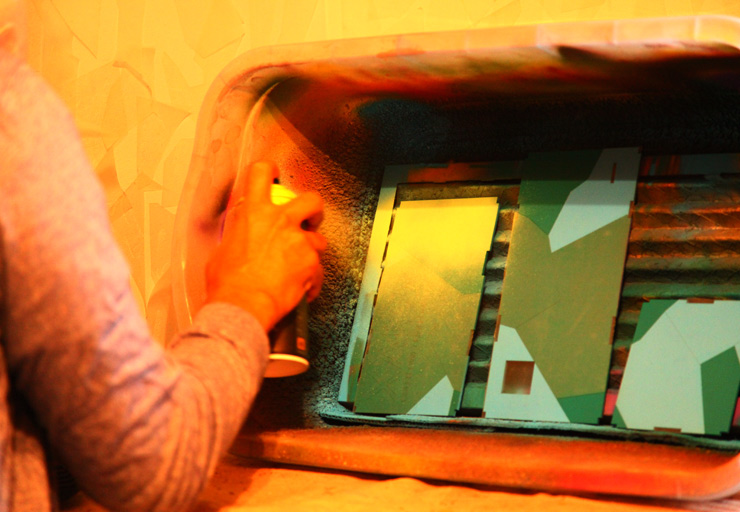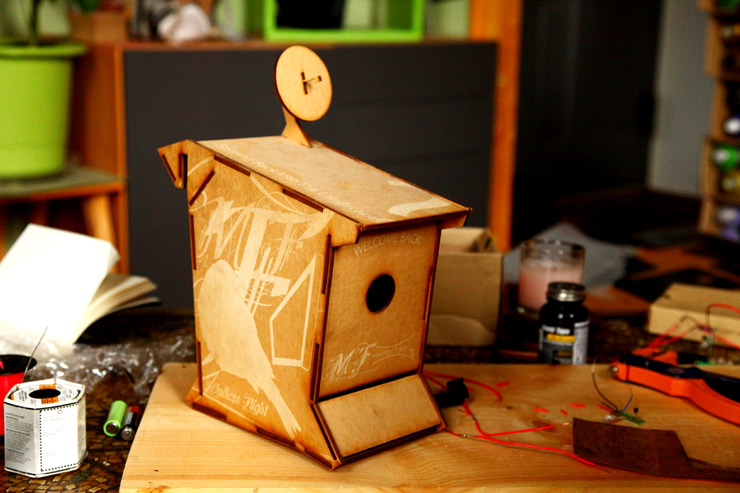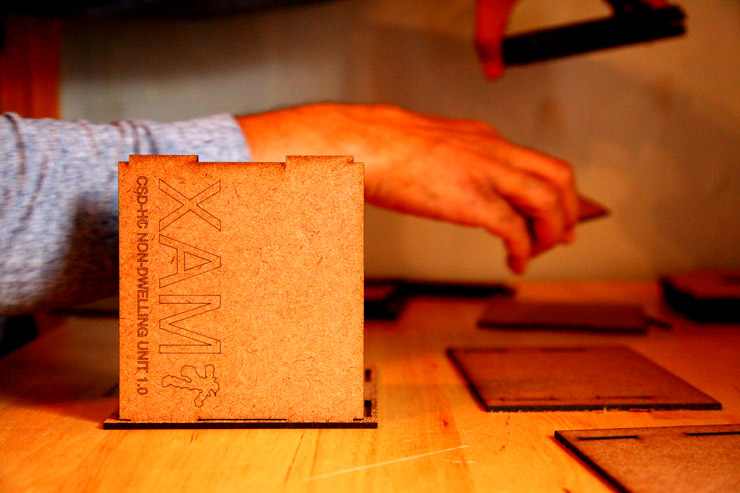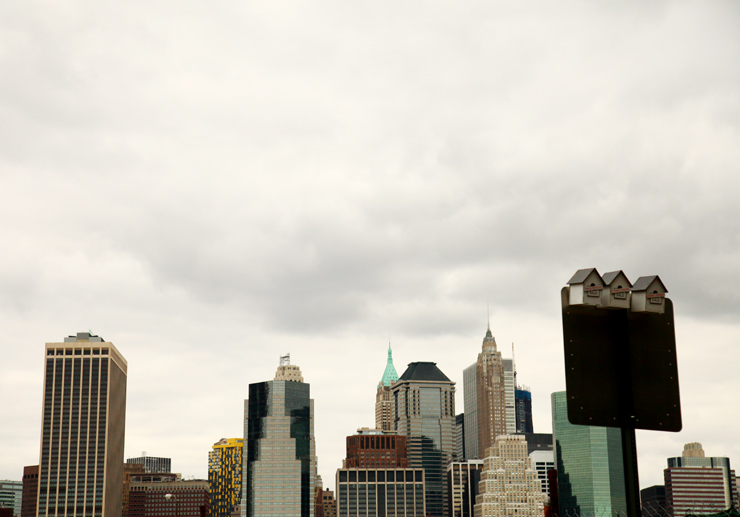Architect to the urban aviary set, Street Artist XAM is one rare bird. Averaging one per week over the last year, the California born former graffiti writer has designed, constructed and installed homes and feeders for New York City birds on street signs above your head.
While studying architecture and object design at the School of the Art Institute of Chicago, he followed an open interdisciplinary structure that allowed him to develop his vision, and made him prove the soundness of his work. “I had very intense conceptual-based architectural studio courses in school that didn’t allow time to slack off, to say the least.”
He points to his years as a student as pivotal in his development as a thinker and artist today. That’s probably why his design, materials, and technical discipline can stand up to academic rigor, but it won’t completely explain why these bird “dwelling units” have a satellite dish for television reception, a solar panel on the roof powering a night light, nor the certain minimalist elegance overlaying it all. Clearly XAM is a Street Artist for more than just the bird watchers and one worth keeping your eye on.
XAM (photo © Jaime Rojo)
With military influenced abbreviation and terminology and a three decimal point precise measurement for components, XAM creates his installations with specific intentions for their use. That said, despite a rigid “rule set” the work has a lot of humor, and even social commentary. There are the Dwelling Units; intended for all the comforts of a modern fine-feathered home, the Feeding Units; a sort of fast food option in your busy bird day, and the brand new Non-Dwelling units; a conceptual project that disallows entry into a “Foreclosed” unit – inspired by our bank-induced housing crises.
For ease of conversation, there is a real need to categorize stuff that happens in the public sphere – and we default to the term “Street Art” or “Art in the Streets” most of the time. But sometimes we find a new category and we lack a sufficient way to describe it. XAM is part architect, engineer, designer, environmentalist, social activist, urban ornithologist, Street Artist, graff writer, and humorist. His output is all within the self-induced confines of a rational process that is defined and re-defined based on results, and whim. The installations actually feed birds and provide shelter to them. They are not commissioned, not permissioned, and not vandalism. They are labor intensive thoughtful one-offs ⎯ a handmade functional sculpture that takes XAM eight to ten hours to complete, and yet you can easily lift it off a sign and take it home.
A very green dwelling unit by Street Artist XAM (photo © Jaime Rojo)
As frequently occurs on the graffiti and Street Art scene, the artist has adopted his nom de guerre, an alternate persona that he inhabits and views the world through when working. It could be an idealized version of himself, or a refracted image of his id. As you might surmise, often the fictional is autobiographical. In this case, XAM says his character is a purple robot.
From his tiny shared Brooklyn apartment, XAM showed us his complete process in detail – converting surfaces and home-made ventilation structures into an economical production facility before our eyes. In the following extensive interview with BSA, XAM’s very first, the artist explains his process, intention, inspiration, and what educational television programming he envisions for the city birds who stop by.
XAM (photo © Jaime Rojo)
Brooklyn Street Art: Can you describe the steps or phases that are necessary to build one dwelling unit?
XAM: With my original dwelling units (CSD series) I did a ton of research on common birds that make use of birdhouses. I read through books, blogs and articles to make sure I fulfilled all requirements in making a proper birdhouse. I then added what I obtained from my contemporary design education to make the units as efficient and self sustainable as possible.
The more I built, the more I took notice of birds in the urban environment and how they were much more adaptable than the research I had been provided by “backyard” birders. I could not find information regarding building birdhouses for use in a city so I learned by observation. From there I started my Sculptural series, which allowed me to create a form that uses less material, identifies the units as more of a contemporary object and removes itself further from the archetype of a bird house.
My steps include;
- Coming up with a design by drawing in Illustrator or on scraps of paper,
- Designing my cutsheets in Illustrator,
- Sending my file off to get cut by my laser cutter,
- Painting my designs and masking for each color,
- Clear coating,
- Soldering the wiring,
- Assembly,
- Clear coating again,
- Hanging my work on a sign near you.
XAM rests on a sign by Street Artist Dan Witz (photo © Jaime Rojo)
Brooklyn Street Art: How does a dwelling unit vary from a feeding unit?
XAM: My dwelling units, unlike my feeding units incorporate passive ventilation, solar panels, LED porch lights (to attract insects), green roofs (for insulation), a food storage area that I fill before hanging and a dwelling space. My feeding units are gravity fed and the feeding trough is refilled from a large food storage cavity.
Brooklyn Street Art: You’ve been a graff writer, street artist, and architect. Somehow this project ties it all together.
XAM: For sure. The form of my original unit was inspired by the letter “I”. The façade is similar to the results you would get from framing sections of a graffiti piece. The exterior also brings me back to when I used to create stencils and the overall form plays with volumes and functions the same way architecture does.
XAM (photo © Jaime Rojo)
Brooklyn Street Art: How do you think your training as an architect impacted your process?
XAM: It has made me a very harsh critic of my own work. I continue to reexamine everything I produce to make sure every detail has intention and serves a purpose. I also find myself trying to make my process more efficient by sourcing cheaper and locally found materials, improving storage (I just designed my own modular storage units), cutting costs, and attempting to lower my carbon footprint.
Brooklyn Street Art: You talk about doing your work and your projects with a sense of “intention”. Can you describe that?
XAM: My units are intended to share my education, interests and to create curiosity. In my eyes, progress comes from education and being curious… I am also aware of street art being ephemeral and so I create my work so that it can easily be removed if seen as a blight to the surrounding community.
XAM (photo © Jaime Rojo)
Brooklyn Street Art: With an almost regimented methodical approach to planning, constructing, and installing, do you ever find that the rule set under which you operate needs to evolve?
XAM: I do see my process as always evolving. By reexamining my creations, I understand more about my results, but interestingly, I have never done the same thing twice. I am always pushing forward and working on the understanding of all my interests regarding my project.
Brooklyn Street Art: From a stylistic perspective, one can see influences of Modernism and Bauhaus in your work. Where and who do you draw your inspiration from?
XAM: Modernism and Bauhaus are two major design/art movements that I do deeply admire. I like the idea of using new materials and technologies to expand the definition of art and design. In a way my units are similar to the Case Study Houses of the late 40’s, 50’s and 60’s.Through research, I try to make the most efficient birdhouses and feeders possible that can be reproduced on a large scale, but retain individuality. I am inspired by artist/designers that push boundaries like Louis Sullivan, Frank Lloyd Wright, Le Corbusier, Victor Horta, Gustav Klimt, Santiago Calatrava, Charles & Ray Eammes, Daniel Libeskind, Eero Saarinen, William McDonough, Mies van der Rohe and so on. At the same time I am also very interested and inspired by biomimicry, movement through space, and removing oneself from the “mundane”.
XAM (photo © Jaime Rojo)
Brooklyn Street Art: Are you encouraging birds to become slovenly dropouts from society by installing Dish network on the dwelling units? Might this contribute to a larger percentage of overweight birds who cannot touch their claws?
XAM: In all honestly I hope the Dish network only encourages the birds to tune into educational programs like Design e², Art 21 and Teenage Mutant Ninja Turtles. The TV package accounts for a large portion of my per unit cost, and I do hope that it is used in productive manner.
Brooklyn Street Art: The patterning on the sides of the units is evocative of camouflage. Were you intending to help the units blend into the environment?
XAM: The interesting thing is, I did not mean for this to happen, but when I look at my intention and manner of execution I realize that the result is camouflage. I simply wanted to play with the juxtaposition between variants of value and size of shapes to create the illusion of foreground and background. I later realized that I was recreating Razzel Dazzel – a camouflage effect used on British naval ships during WWI and also a short lived art movement.
XAM (photo © Jaime Rojo)
Brooklyn Street Art: When you talk about XAM, he is a third person – a robot with a specific personality and set of behaviors or attitudinal characteristics.
XAM: I found it interesting that in graffiti, street art and logo design, an identity is associated to your name. The companies, street art and graffiti that I found myself remembering and interested in have a strong identity that remains consistent… I spell XAM in all sans serif caps because I like the strong architectural structures that the letters create. XAM is a larger than life rogue-bot with a destructive interest in contemporary architecture. He destroys the architecture that he loves so much to investigate its functions, but he can’t help it due to the way he was programmed. Remorse is deeply felt by him, so to give back he creates contemporary birdhouses for communities around the world. As a kid I use to love to destroy electronics to understand their functions. In a way XAM is The Hulk and I’m Dr. Bruce Banner.
Brooklyn Street Art: Do you have any other personalities, or is it pretty much you and XAM?
XAM: XAM is my only personality, but as I progress in creating work around XAM, I realize he has more interests needing to be expressed, therefore expect to see a lot of new work as time progresses.
XAM (photo © Jaime Rojo)
Brooklyn Street Art: Your method of installation; using a custom designed utilitarian “Swiss Amy knife” all-in-one tool, leaves the unit resting upon a sign. Why not make the installation more permanent?
XAM: I like the community to decide the longevity of my work. I guess I like playing with ‘Grey Areas’. Are we supposed to accept and/or appreciate the units because they are in a way trying to reverse our destructive effects on nature? Or should we remove them because they are illegally placed? I like to provoke thought and challenge our belief system as well as expand definitions.
XAM (photo © Jaime Rojo)
Brooklyn Street Art: You include a small QR code on the bottom of each unit. Where does that take someone if they scan it?
XAM: The QR code is located on the unexposed back of each unit and is intended to be discovered by the person who decides to remove my units. When scanned you are taken to a list of facts that explains how we benefit from birds in the urban environment. You’re asked a question of morality, then you are given my email address to bring up any comments or concerns.
Brooklyn Street Art: Sometimes the placement on a sign blocks the letters of the sign. Does that endanger anyone?
XAM: Many signs are printed on both sides. What appears to be the cover up of an important message is just a waste of paint due to the direction of traffic never facing the back of the signs. A piece that I put up last March in NY is still hanging on a one way sign and I believe it is for this reason. I am making use of a common useless space.
XAM (photo © Jaime Rojo)
Brooklyn Street Art: How long does a typical unit remain on the street where you place it? Have you ever seen one being taken?
XAM: It all depends on where it has been placed. When hanging in Willamsburg, Brooklyn the units last about as long as a scoop of ice cream in the Sahara Desert. When mounted in industrial parts of LA, I see units remaining up from multiple visits prior. It all depends on location. I tend to avoid Willamsburg these days due to the lack of longevity.
XAM (photo © Jaime Rojo)
Brooklyn Street Art: Can you talk about how sustainability enters into the planning of each unit?
XAM: I make sure that my units have no unnecessary functional attributes. I use a structural material that is the byproduct of another process. I take advantage of resources that are renewable (the sun, gravity, plant life, and weather). Environmental ethics are deeply seeded into all my work.
Brooklyn Street Art: Have you considered creating your custom materials?
XAM: I am very interested in getting involved in as many aspects of the project as possible. I would love to eventually make my own paint, structural materials, solar panels, energy storage units and bounding agents. As time progresses, I know I will only get deeper into my process and have my hand involved in more aspects.
XAM (photo © Jaime Rojo)
Brooklyn Street Art: The spraying process alone is so impressive with the pragmatic selection of materials and venting, and economical use of space…
XAM: Originally I had a studio near my apartment. (After that) I was painting my units on the streets in cardboard boxes. I tried to find a place to rent a spray booth by the hour, but eventually I drew up plans and made my own. I now paint in my house using a retrofitted storage bin that has a bathroom fan for ventilation, a heater filter to catch paint and other partials – plus a dryer tube to guide the exhaust out my window.
XAM (photo © Jaime Rojo)
XAM (photo © Jaime Rojo)
Brooklyn Street Art: Initially the color palette was purple, lavender? Why? Why did it change?
XAM: The exterior of all the units is actually composed of fragments of XAM. I scale and crop sections of XAM’s body to create compositions on the façade, then I paint them in multiple values. Originally I used a monochromatic color scheme of purples because XAM is purple and his body is what wraps the surface. Slowly I phased out that rule by using at least one purple. Now it no longer matters to me because I have always been interested in the use of color.
Brooklyn Street Art: If Dish TV approached you to do a collaborative project, would you dress as a purple robot for the commercial?
XAM: I wouldn’t want to sellout by being XAM in a Dish TV commercial. I would rather be an extra in the background dressed up as Sweetums, the big scary, hairy monster from the Muppets who is nothing more than a gentle giant. Wait, that sounds kind of like XAM…
The original prototype for the Dwelling Unit. XAM (photo © Jaime Rojo)
XAM (photo © Jaime Rojo)
Brooklyn Street Art: Not only do you utilize nearly the entirety of a sheet of tempered hardwood, you use your relatively small living space as your workspace also. Would you prefer a separate studio, or do you like to challenge yourself to maximize resources?
XAM: I always make sure I minimize my waste and make all parts of my process as efficient as possible. I have been offered a free studio that is probably 10+ times the size of my entire apartment, but I don’t feel I need that much space. I like the intimacy and the efficiency I experience by having to work in a small space. My work is modular and packs flat so it is all about using space and material efficiently. I feel working in a small space reinforces my design philosophy.
XAM (photo © Jaime Rojo)
Brooklyn Street Art: Can you talk about your new collection of foreclosed units and the intersection with social or political advocacy?
XAM: I feel my work has always had a social and political voice, but one that may not have been realized on a large scale, perhaps understood more by contemporary designers. With the introduction of my NON-DWELLING series I feel I have created a voice that hits home and that a larger audience can understand. By creating what I view as the same spectrum, I hope to open up an opportunity to understand my CSD work. In a way, I am giving a thought provoking solution or option (CSD series) to a problem we face (NON-DWELLING series).
Brooklyn Street Art: You have a vision of how the “Foreclosed” units will change over time, right? It kind of makes me think of squatters and homeless people taking over abandoned real estate.
XAM: With my NON-DWELLING units I have glued the structure with waterproof wood glue and the mounted signage with water resistant wood glue. I look at America as a country that is constantly reinventing itself over time. With time we will discover a solution to our housing crisis and with time (and weather) the “Price Reduced”, “Foreclosure” and “Bank Owned” signs will fall from the units and allow birds to live in the once vacant houses… To be honest, I would love it if homeless birds were to expedite the process and remove the signs themselves.
XAM (photo © Jaime Rojo)
Brooklyn Street Art: Do you see your work going forward containing more message-driven content?
XAM: I feel like my work has a message behind it, but I am beginning to realize that it may not be so obvious or people don’t care enough to realize it. I will continue to figure out ways to deliver the same message with different work.
Brooklyn Street Art: What motivates you to do this project? In the last 12 months you must have spent 1,000 hours of your life doing this.
XAM: In my eyes the design process only ends when you decide to step away from it or deadlines require you to do so. There is always room for more research, investigation and understanding. My project has no final deadline to meet and endless amount of opportunities to reinvestigate, therefore I continue to work at it. I am an artist/designer that is very interest in the process. Once the work is done and examined, I move on to the next area of investigation. On top of that I love to explore. Crossing my design interests with street art fulfills all my needs.
XAM (photo © Jaime Rojo)
This article was also published on The Huffington Post,
Other Articles You May Like from BSA:
A place you may not have heard of, Réunion Island has quickly become a remarkable hotspot for urban art, largely due to the Réunion Graffiti Festival. This annual gathering showcases a rich range of ...
New York, New York, in the thick of summer. The heat is heavy with humidity, smells of hotdogs, marijuana, perfume, piss. The flat screen sunglasses now on every sweet face hide the glances and ...
Street artist and muralist GAIA just finished a new tribute in Lexington, Kentucky with the PRHBTN gallery focused on a local colorful character named James Herndon, aka “Sweet Evening Breeze.” G...
Rachel Carson died on this day in 1964 – her life awakening man/womankind’s environmental conscience. Today on Earth Day we remember that corporations hire PR firms to tell us misinformation abou...
“The XXXL Panta Burger” You are what you eat. Mr Fijodor thinks we are eating cars, buildings, cities and a few other non-foods along with all the other stuff in this stack of hamburgers. Of course, h...
 BROOKLYN STREET ART LOVES YOU MORE EVERY DAY
BROOKLYN STREET ART LOVES YOU MORE EVERY DAY

























